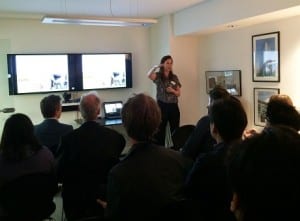Mike Fell gives the background to a recent co-authored paper which explores what people think about efforts to influence when they use electricity.
What does it mean to be “in control” in relation to energy? And why does it matter? It’s perhaps easier to begin with the second question.
The subject of electricity blackouts has been big in the news recently. While the risk of blackouts is low, the continuing closure of older coal-powered generators means that there is less and less spare capacity on the grid to meet peaks in electricity demand.
 One way to increase capacity is build more generators. Another is reduce demand, or attempt to alter the timing of demand to avoid getting such high peaks. The latter (known as demand-side response or DSR) can be achieved in a number of ways, such as by charging a higher price per unit of electricity at peak times (like in Economy 7). Alternatively, a signal can be sent directly to technology (such as fridges or electric heating systems) in people’s homes telling it to use more or less electricity at certain times.
One way to increase capacity is build more generators. Another is reduce demand, or attempt to alter the timing of demand to avoid getting such high peaks. The latter (known as demand-side response or DSR) can be achieved in a number of ways, such as by charging a higher price per unit of electricity at peak times (like in Economy 7). Alternatively, a signal can be sent directly to technology (such as fridges or electric heating systems) in people’s homes telling it to use more or less electricity at certain times.
Demand-side response can only be effective if enough people decide to take part, so that enough demand for electricity (or “load”) can be moved around in time. However, research into what people think about it (and some press coverage) suggest that this wide participation is by no means assured. One of the key concerns expressed is around “loss of control”, where some third party attempts to influence (or even directly control) people’s electricity use.
It is important to understand this concern if DSR programmes are to be designed in such a way that people want to take part. So what does it actually mean to be “in control” in relation to energy, and how do people think this might change under different ways of doing DSR?
We held group discussions with people we expected to have different experiences of control in relation to energy. Some had gas central heating (with comparatively high individual control of heating) while some had district heating (their heating was externally controlled – they didn’t have room thermostats). Some were already on a time of use electricity tariff. The anonymous quotes in the rest of this post come from these groups.
Rather than there being a simple idea of “control over energy”, a number of different dimensions of control emerged:
- Control over the services that energy provides us with (and which lead to comfort, e.g. heat, light, etc.).
- Control over timing, or the feeling of being able to do things when you want.
- Control over how much you spend on energy.
- A general sense of control and independence in one’s life (autonomy).
When people thought about different ways of doing DSR, these dimensions of control were all affected in different ways. Often with time of use pricing people felt they would have more control over spending (‘you have got some more control cause you can look at the, “oh right OK let’s put the washing machine on now”’), but less flexibility in when they did things and potentially over comfort.
This was especially true of “dynamic” time of use pricing, where electricity prices can be different every day – unlike tariffs such as Economy 7 which remain the same week after week. Such dynamic tariffs allow the possibility of making the most of variable wind generation, but were thought (by people in the groups) to be problematic due to their unpredictable nature and the extent to which people would be reliant on automation to make the most of them (‘We’re not robots!’).
In the case of direct control of technology, some people were worried about overall loss of autonomy – a sort of “Big Brother” scenario (‘That means they’re controlling your life basically’). Others weren’t so concerned about this so long as it happened in the background and allowed them to get on with their lives as they chose (‘If it’s … something that happens in the background and doesn’t actually affect your usage … for me personally I don’t think I have an issue with them controlling it’).
These results suggest some challenges for DSR. How to retain the attractive sense of control over spending that time of use pricing offers, while minimizing worries about flexibility? Perhaps personalizing tariffs to households’ individual circumstances could hold the key. In the case of direct control of technology there are certainly people who are implacably against this form of external influence, while others may happily accept it under the right conditions (e.g. with the possibility to override it). But these conditions must strike a balance between acceptability and the aim of getting demand reductions with appropriate speed, duration and reliability.
The findings also suggest the usefulness of looking at control in a systematic way. Indeed, this approach has informed our subsequent research which used a representative survey of Great Britain to find out more about people’s preferences for different DSR electricity tariffs. We hope to post more on the findings of this work soon.
Read the full paper here: Exploring perceived control in domestic electricity demand-side response, Michael J. Fell, David Shipworth, Gesche M. Huebner & Clifford A. Elwell, published in Technology Analysis & Strategic Management volume 26, issue 10, 2014.
Tags: demand-side response, time of use tariffs, direct load control, perceived control, electricity, domestic
Photo: “Happy Show” (cropped) by Sameer Vasta under a Creative Commons licence.
 Close
Close





